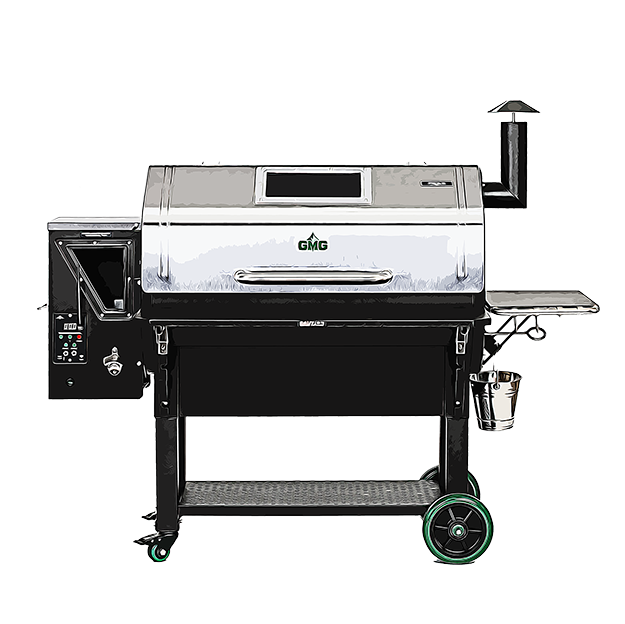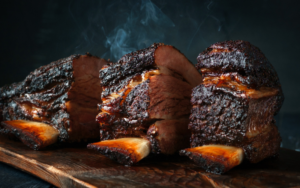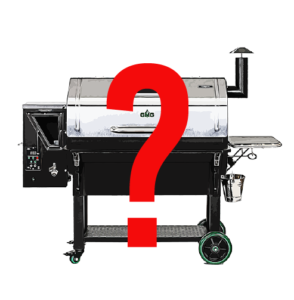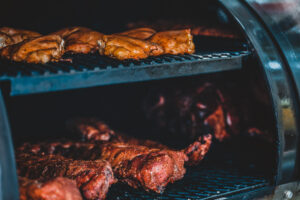Pellet Grill or Pellet Smoker?
Before we answer the question of what is a pellet smoker, we also have to understand that this type of grilling system is often called a pellet grill as well. We could just as easily ask, what is a pellet grill? The answer would be the same. I refer to them either way personally and don’t think it matters to the craft.
I have mentioned this on here before, but in 2016 I bought my first (and still current) pellet grill without knowing a thing about them. I empathize with the individuals out there just looking to get into the craft and research as much as possible. Owning and subsequently cooking great barbecue is fun, especially when family, friends, and good times are involved. I don’t advise just going out there and buying the first pellet grill you see.
A pellet grill is…
A pellet grill is a grilling system that uses hardwood pellets to smoke various cuts of meat to produce mouthwatering barbecue. The grilling area usually has a large peaked chamber, and the reason for this is to smoke large cuts of meat. Think pork shoulder, brisket, whole turkeys…you get the idea.
Next to the grilling area will sit a hopper. The hopper is what holds the hardwood pellets. It is important to differentiate wood pellets from hardwood pellets. The reason comes down to wood species and flavor. Using apple, pecan, or hickory pellets each yields different essence of smoke which imparts unique flavor profiles to the barbecue. Heated smoke has a way of adding complex savory notes to any dish prepared on the smoker.
The hopper is generally sized for the surface area in the grilling chamber. Grilling chambers are measured in square inches. You can have anywhere from 200 sq. in. to over 1,000 sq. in. for options in size. In a 200 sq. in. pellet grill (usually slated as portable), the hopper will hold around 4 pounds. In a 1,100 sq. in. pellet grill, the hopper will hold 30 pounds or more of pellets.
Set it, and watch the magic happen
Here is the good part. A pellet grill uses digital controllers with a straightforward user interface. What that means is, there is a digital control board that accepts input from the user to set temperature. If I were smoking a rack of ribs or 3 I would set my temperature to 200 degrees. With some advanced logic, the pellet grill starts to relay information back and forth to itself. Additionally, I can tell my pellet grill to set at 200 degrees for 6 hours, and it will precisely carry on the orders.
At this point, the pellet grill is very black and white. I want it to reach and maintain a temperature of 200 degrees. When I plug it in (to a typical household-type outlet) the start-up sequence begins. The hardwood pellets are fed to the firebox in the center of the grilling chamber by way of an auger. Once the hardwood pellets are in the firebox an igniter glows red hot setting the pellets on fire. Then, a convection fan stokes the newly formed fire, smoke, and circulates the heated smoke.
In order to reach the initial temperature, the control board is taking info from temperature sensors. The temperature must rise, so more hardwood pellets are fed to the firebox, and the fan speed varies to stoke a roaring fire. It’s quite amazing what goes on behind the scenes. The firebox is approximately the size of a Kleenex box and has a cup that accepts the pellets. That firebox, though, is the heart of maintaining and providing heat.
We are now at temperature, and you will see that the pellet grill goes into strict consistency. The orchestra of pellets being fed to the firebox, the fan stoking the fire at variable speed, and the temperature sensors proving constant feedback to the control board…is a thing of beauty. The pellet grill is a master at indirect heat.
Indirect heat…its science
That’s exactly how it cooks. The pellet grill once at temperature is ready for whatever cut of meat, side dish, or appetizer you want to throw at it. The grilling chamber fills with a beautiful blue-hued smoke that is generated from burning the hardwood pellets in the firebox. That smoke carries heat, and with convection is constantly circulated completing the cooking process by virtue of indirect heat.
Low and slow temperatures, like ribs on the smoker for 6 hours at 200 degrees slowly, delicately, and masterfully tenderize the meat. The flavor profile with the smoke flavor, seasoning on the meat, and rendered fat create a complex reaction that is hard to duplicate by any other grilling method.
As complicated as that may sound, the end-user experience is actually quite simple and straightforward. For any typical smoke, this is my routine.
- Plug in my pellet grill (outdoor receptacle)
- Hit the switch to on, and let the grill warm up with its start-up sequence
- Set the temperature (I will set mine to 250 degrees)
- Back inside, I put my favorite dry rub on a room temperature pork shoulder
- I come back out, open the grill lid, and put the pork shoulder in the center of the grilling chamber
- I let the smoker do the work, and I enjoy a few well-deserved beverages
That’s correct, its that simple
This whole process takes about 15 minutes…you heard that right. It really is that simple. Pellet grills are versatile. They have the ability to smoke, sear, bake, braise, roast, and grill. Pellet grills are consistent and precise, meaning there aren’t many other grilling systems (other than a charcoal smoker, or a traditional offset smoker if you’re good) that can maintain heat at a constant temperature as a pellet grill does.
Maintaining heat is possible because of the relationship between the controller logic board, temperature sensors, and auger automatically feeding the firebox. This constant feedback loop is virtually unmatched.
I’ll leave you with this. I believe there is value in spreading the word on the craft of pellet smokers. The value is that the craft really just wants to make great-tasting barbecue that can be enjoyed by friends and family. We could all use a sense of community nowadays, and what better way than gathering in a backyard having a good time. Pellet smokers, pellet grills, whatever you want to call them make it easy, give you time back and produce consistent results smoke after smoke.
Keep the craft alive,
David



